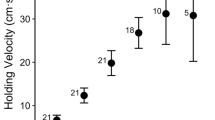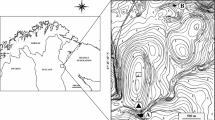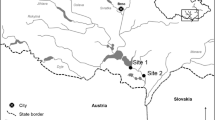Abstract
I assessed the impact of both drift-feeding (Salmo trutta, brown trout) and benthic-feeding (Cottus gobio, bullhead) fish on a benthic assemblage during a 1-month-long field experiment. I used enclosures containing cobble/gravel substrata with 6-mm mesh net that allowed invertebrates to drift freely in and out of enclosures. Four treatments, arranged in a factorial design, were tested: a predator-free control, bullheads only (2.67 bullheads/m2, two per enclosure), brown trout only (2.67 brown trout/m2, two per enclosure), and bullheads and brown trout together (2.67 fish/m2, one of each). Bullheads reduced the densities of seven invertebrate taxa (Gammarus pulex amphipods, Baetis rhodani mayfly nymphs, Leuctra spp. stonefly nymphs, Polycentropus spp. caddis larvae, Pacifastacus leniusculus signal crayfishes, Simuliidae, blackfly larvae, and Limnephilidae, caddis larvae) whereas brown trout only affected one taxon (B. rhodani). The weaker effect of brown trout on benthic prey was probably related to its heavy reliance on terrestrial prey. Dietary analyses showed that more than 80% of prey consumed by brown trout were terrestrial animals, whereas bullhead only consumed benthic prey. Neither bullhead nor brown trout affected the absolute number of immigrating or emigrating invertebrates in enclosures, but bullhead affected the per capita emigration rates of G. pulex. Direct predation by bullhead was more important than avoidance behaviour (drift) in determining densities of six of the seven taxa; only G. pulex densities were equally affected by avoidance behaviour and direct predation. Direct predation by brown trout was also more important in determining densities of B. rhodani. The presence of bullhead raised periphyton biomass, presumably mediated via their consumption of grazers. Brown trout had no effect on periphyton biomass and these results indicate that the presence of alternative prey, in this case terrestrial animals, may have repercussions for fish-benthic macroinvertebrate-periphyton interactions and may potentially explain some of the variable impacts of fish on benthic macroinvertebrates that have been reported in the literature.
Similar content being viewed by others
Author information
Authors and Affiliations
Additional information
Received: 18 December 1997 / Accepted: 4 May 1998
Rights and permissions
About this article
Cite this article
Dahl, J. Effects of a benthivorous and a drift-feeding fish on a benthic stream assemblage. Oecologia 116, 426–432 (1998). https://doi.org/10.1007/s004420050606
Issue Date:
DOI: https://doi.org/10.1007/s004420050606




